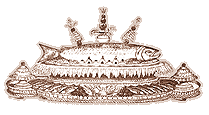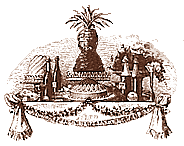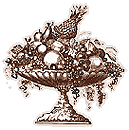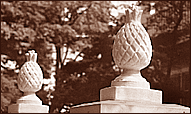SOCIAL HISTORY OF THE PINEAPPLE
Being the Brief and Colorful Story of a Truly American Plant
By Hoag Levins
THE PINEAPPLE has served as both a food and a symbol throughout the human history of the Americas. Originally unique to the Western Hemisphere,  the fruit was a culinary favorite of the fierce Carib Indians who lived on islands in the sea that still bears their name. Indian Migration
The presence of pineapples on Caribbean islands was not a natural event, but rather the result of centuries of indian migration and commerce. Accomplished dugout canoe navigators, the maritime tribes explored, raided and traded across a vast expanse of tropical oceans, seas and river systems. The herbaceous plant they called "anana," or "excellent fruit," originally evolved in the inland areas of what is now Brazil and Paraguay and was widely transplanted and cultivated. Highly regarded for its intense sweetness, the "excellent fruit" was a staple of indian feasts and rites related to tribal affirmation. It was also used to produce Indian wine.
Christopher Columbus
 The first encounter between a European and a pineapple occurred in November, 1493, when Christopher Columbus, on his second voyage to the Caribbean region, lowered anchor in a cove off the lush, volcanic island of Guadaloupe and went ashore to inspect a deserted Carib village. There, amidst parrot-flecked jungle foliage and wooden pillars spiraled with serpent carvings, his crew came upon cook pots filled with human body parts. Nearby were piles of freshly gathered vegetables and fruits, including pineapples. The European sailors ate, enjoyed and recorded the curious new fruit which had an abrasive, segmented exterior like a pine cone and a firm interior pulp like an apple. The first encounter between a European and a pineapple occurred in November, 1493, when Christopher Columbus, on his second voyage to the Caribbean region, lowered anchor in a cove off the lush, volcanic island of Guadaloupe and went ashore to inspect a deserted Carib village. There, amidst parrot-flecked jungle foliage and wooden pillars spiraled with serpent carvings, his crew came upon cook pots filled with human body parts. Nearby were piles of freshly gathered vegetables and fruits, including pineapples. The European sailors ate, enjoyed and recorded the curious new fruit which had an abrasive, segmented exterior like a pine cone and a firm interior pulp like an apple.
Renaissance Europe
The Renaissance Europe to which Columbus returned with his discoveries was a civilization largely bereft of common sweets. Sugar refined from cane was a rare commodity imported at great cost from the middle east and orient. Fresh fruit was also a rare item; orchard-grown fruit being available in only limited varieties for brief periods of time.
Pineapple: Treat of Kings
In such a gastronomic milieu, reports and later samples  of the New World's pineapple--whose ripe yellow pulp literally exploded natural sweetness when chewed--made the fruit an item of celebrity and curiosity for royal gourmet and horticulturist alike. Despite dogged efforts by European gardeners, it was nearly two centuries before they were able to perfect a hothouse method for growing a pineapple plant. Thus, into the 1600s, the pineapple remained so uncommon and coveted a commodity that King Charles II of England posed for an official portrait in an act then symbolic of royal privilege -- receiving a pineapple as a gift. of the New World's pineapple--whose ripe yellow pulp literally exploded natural sweetness when chewed--made the fruit an item of celebrity and curiosity for royal gourmet and horticulturist alike. Despite dogged efforts by European gardeners, it was nearly two centuries before they were able to perfect a hothouse method for growing a pineapple plant. Thus, into the 1600s, the pineapple remained so uncommon and coveted a commodity that King Charles II of England posed for an official portrait in an act then symbolic of royal privilege -- receiving a pineapple as a gift.
Pineapples and Colonial America
Across the ocean, the pineapple took on other symbolic meanings in England's American colonies. The colonies were then a land of small, primitive towns and settlements where homes served as the hubs of most community activity. Visiting was the primary means of entertainment, cultural intercourse and news dissemination. The concept of hospitality--the warmth, charm and style with which guests were taken into the home--was a central element of the society's daily emotional life.
Creative Food Display in Colonial America
Creative food display--the main entertainment during a formal home visit--was a means by which a woman declared both her personality and her family's status. Within the bounds of their family's means, hostesses sought to outdo each other in the creation of memorable, fantasy-like dining room scenes.  At such feasts, tabletops resembled small mountain ranges of tiered, pyramided and pedestaled foodstuffs often drizzled and webbed in sugar, studded with china figurines, festooned with flowers and interwoven with garlands of pine and laurel. Dinners were extravaganzas of visual delights, novel tastes, new discoveries and congenial conversation that went on for hours. At such feasts, tabletops resembled small mountain ranges of tiered, pyramided and pedestaled foodstuffs often drizzled and webbed in sugar, studded with china figurines, festooned with flowers and interwoven with garlands of pine and laurel. Dinners were extravaganzas of visual delights, novel tastes, new discoveries and congenial conversation that went on for hours.
Rare Pineapple: King of Colonial Fruits
 While fruits in general--fresh, dried, candied and jellied--were the major attractions of the community's appetite and dining practices, the pineapple was the true celebrity. Its rarity, expense, reputation and striking visual attractiveness made it the ultimate exotic fruit. It was the pineapple that came to literally crown the most important feasts: often held aloft on special pedestals as the pinnacle of the table's central food mound. While fruits in general--fresh, dried, candied and jellied--were the major attractions of the community's appetite and dining practices, the pineapple was the true celebrity. Its rarity, expense, reputation and striking visual attractiveness made it the ultimate exotic fruit. It was the pineapple that came to literally crown the most important feasts: often held aloft on special pedestals as the pinnacle of the table's central food mound.
The Colonial Pineapple Trade
Ships brought in preserved pineapples from Caribbean islands as expensive sweetmeats--pineapple chunks candied, glazed and packed in sugar.  The actual whole fruit was even more costly and difficult to obtain. Wooden ship travel in the tropics was hot, humid and slow, often rotting pineapple cargoes before they could be landed. Only the speediest ships and most fortuitous weather conditions could deliver ripe, wholesome pineapples to the confectionery shops of cities such as Boston, Philadelphia, Annapolis and Williamsburg. The actual whole fruit was even more costly and difficult to obtain. Wooden ship travel in the tropics was hot, humid and slow, often rotting pineapple cargoes before they could be landed. Only the speediest ships and most fortuitous weather conditions could deliver ripe, wholesome pineapples to the confectionery shops of cities such as Boston, Philadelphia, Annapolis and Williamsburg.
A hostesses's ability to have a pineapple for an important dining event said as much about her rank as it did about her resourcefulness, given that the street trade in available fresh pineapples could be as brisk as it was bitchy. So sought after were the prickly fruits that colonial confectioners sometimes rented them to households by the day. Later, the same fruit was sold to other, more affluent clients who actually ate it. As you might imagine, hostesses would have gone to great lengths to conceal the fact that the pineapple that was the visual apogee of their table display and a central topic of their guests' conversation was only rented.
Pineapple as Hospitality Symbol
 In larger, well-to-do homes, the dining room doors were kept closed to heighten visitors' suspense about the table being readied on the other side. At the appointed moment, and with the maximum amount of pomp and drama, the doors were flung open to reveal the evening's main event. Visitors confronted with pineapple-topped food displays felt particularly honored by a hostess who obviously spared no expense to ensure her guests' dining pleasure In larger, well-to-do homes, the dining room doors were kept closed to heighten visitors' suspense about the table being readied on the other side. At the appointed moment, and with the maximum amount of pomp and drama, the doors were flung open to reveal the evening's main event. Visitors confronted with pineapple-topped food displays felt particularly honored by a hostess who obviously spared no expense to ensure her guests' dining pleasure
In this manner, the fruit which was the visual keystone of the feast naturally came to symbolize the high spirits of the social events themselves; the image of the pineapple coming to express the sense of welcome, good cheer, human warmth and family affection inherent to such gracious home gatherings.
Pineapple as Artistic Motif
It is hardly surprising that this communal symbol of friendship and hospitality also became a favorite motif of architects, artisans and craftsmen throughout the colonies. They announced the hospitality of a mansion with carved wood or molded mortar pineapples on its main gate posts such as those shown here at a home in historic Haddonfield, New Jersey.

Photo: Hoag Levins
|
Carved wooden pineapple gate posts at a home in Haddonfield, N.J.
|
They incorporated huge copper and brass pineapples in the weather vanes of their most important public buildings. They sculpted pineapples into door lintels; stenciled pineapples on walls and canvas mats; wove pineapples into tablecloths, napkins, carpets and draperies; and cast pineapples into metal hot plates. There were whole pineapples carved of wood; pineapples executed in the finest china kilns; pineapples painted onto the backs of chairs and tops of chests.
Tabletop Whimsy
Whimsical pineapple shapes and interpretations became a ubiquitous form for "fun" food creations and general table decorations throughout the 1700 and 1800s. There were pineapple-shaped cakes, pineapple-shaped gelatine molds, candies pressed out like small pineapples, pineapples molded of gum and sugar, pineapples made of creamed ice, cookies cut like pineapples and pineapple shapes created by arrangements of other fruits. There were also ceramic bowls formed like pineapples, fruit and sweet trays incorporating pineapple designs, and pineapple pitchers, cups and even candelabras.
During the last century, the art of food display centered around the pineapple has faded to a quaint craft now largely associated with the making of certain kinds of Christmas decorations. These holiday fabrications are one of the few vestiges of an era when all life literally revolved around the dining room table; a less complicated era that left us the enduring icon of the colonial pineapple, a truly American fruit symbolizing our founding society's abiding commitment to hospitality as well as its fondest memories of families, friends and good times.
All Rights Reserved © 1995-2009, Hoag Levins
Contact Author: HoagL@earthlink.net
| 

